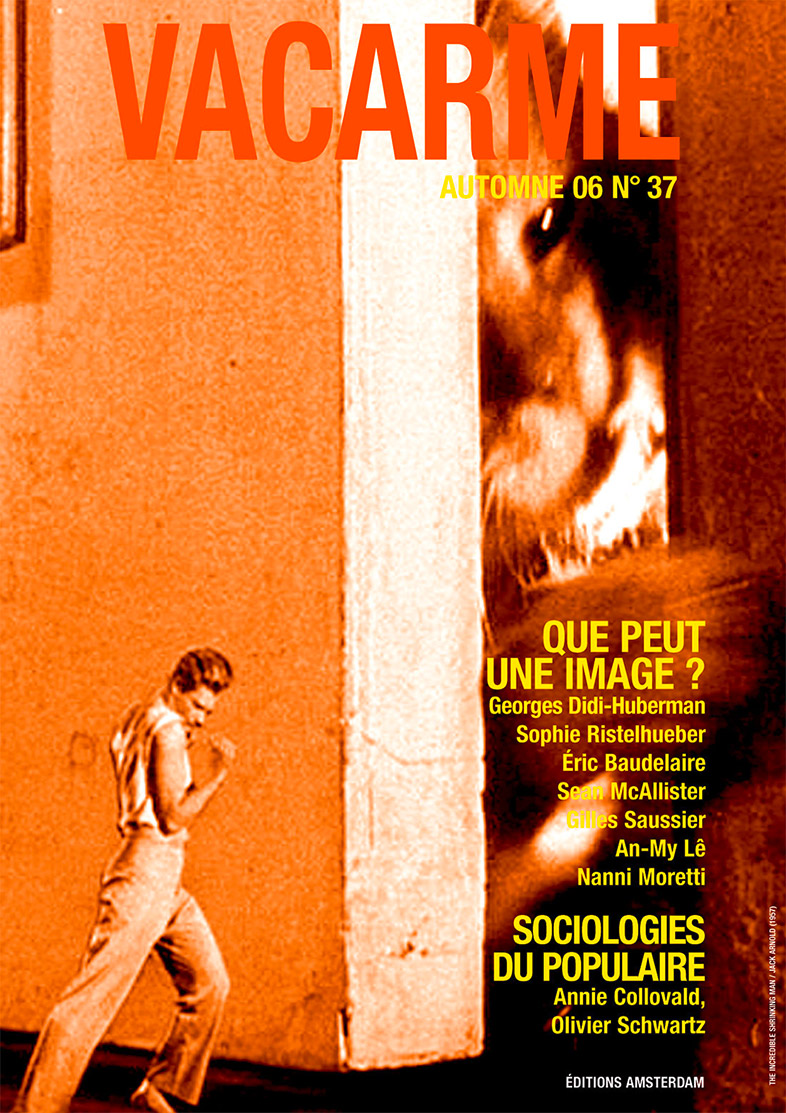Vacarme 37
automne 2006

À nos lectrices et lecteurs
Ce numéro, Vacarme 37 (automne 2006), est désormais archivé et tous ses articles sont accessibles dans leur intégralité. Vacarme aime la gratuité, mais une revue existe grâce à ces abonné·es.
Chantier
artistes en guerre
artistes en guerre ?
avant-propos Lire →
la mise à nu des choses
entretien avec Sophie Ristelhueber Lire →
onze cratères, « Eleven Blowups »
par Laure Vermeersch
s’exposer aux images des bombardements Lire →
portrait du réalisateur en amoureux politique
entretien avec Sean McAllister Lire →
méditation documentaire
entretien avec Gilles Saussier Lire →
l’échange documentaire
par Philippe Mangeot
l’espace commun du film et de son objet Lire →
hors champ
par Sophie Jaulmes
fragilités et nécessité de l’image documentaire Lire →
Portfolio
par Éric Baudelaire, An-My Lê, Sophie Ristelhueber & Gilles Saussier
Un portfolio signé Éric Baudelaire, An-My Lê, Sophie Ristelhueber et Gilles Saussier. Lire →
théâtre des dernières guerres
par Michel Poivert
du théâtre des opérations à la scène photographique Lire →
la fresque aux icônes
par Pierre Zaoui
« The Dreadful Details », un diptyque de guerre Lire →
artists at war ?
by Pierre Zaoui
It is as impossible to recapture the pain and terror of war as it is to truly remember the agony of an infected tooth. Moritz Thomsen, My Two Wars.
We instinctively understand that images are part of war. From paintings of war to the petrified Gorgon’s head on Theseus’s shield, from ancient dramatisations of surrender to Hitlerian propaganda, from Machiavellian ruses to the use of video by terrorist groups, everyone accepts that the essence of any war relies on a rapport between images at (…)
Lire →
portrait of the filmmaker as political lover
by Laure Vermeersch
interview with Sean McAllister Lire →
the documentary exchange
by Philippe Mangeot
According to geographers, two things describe a city: its natural setting and its place in the interplay of exchanges. Similarly, documentaries define their space at the junction between a location and a link; the landscape they display is weaved from the transactions carried out around of the lens, which senses what is shared and what is not. Documentary ethics are a human geography.
In Buster Keaton’s The Cameraman, a title card serves as a prologue to the story proper: “When acclaiming (…)
Lire →
the fresco of icons
by Pierre Zaoui
Eric Baudelaire photographed the second (or third) Iraq war in Hollywood, on a set used by a number of actual TV productions, with thoughts of Over There in his mind. The work that resulted is both a radical critique and layered apology of those clichés that haunt our souls, our screens and our literature. Let us try to understand how this apology can be thus woven into the critique, to a point where both the images of war and their traditional justifications seem linked in an infinite (…) Lire →